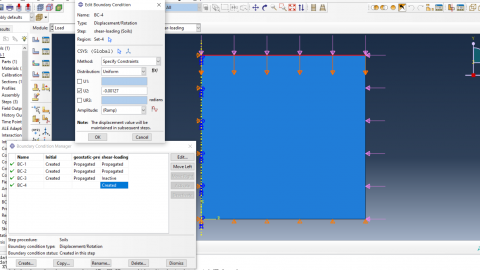Dear Prof. Masin and Soil Model Community,
I am using HP clay subroutine in Plaxis 3D to simulate soil structure interaction problem. I want void ratio and OCR variation along the depth to back analyse centrifuge test. In Plaxis, either or OCR remains constant depending on input. Moreover, I found HP subroutine in plaxis calculate void ratio without considering kheppa line. Please see details and explanations in the attached images. My objective is to obtained initial void ratio and OCR variation along the model depth. Also, I want to confirm the position of e input in parameters in ln(1+e) – lnp space. Thanks
HP clay subroutine in Plaxis
Related Articles
-
Problem in simulating CPT using SANISAND04
 an zhanng||Finite Elements|6 |Views 1,452
an zhanng||Finite Elements|6 |Views 1,452
I have a question regarding the simulation of cone penetration tests using the SANISAND04 model. I have observed that the parameter m (yield surface size)has a significant impact on the […] -
-
How to replicate results for vertical cut in FEM program
 Amine Aboufirass||Finite Elements|0 |Views 3,488
Amine Aboufirass||Finite Elements|0 |Views 3,488
The equations for a vertical cut in cohesive material are given in several publications including Heyman (1973): The stability of a vertical cut (see attachment Equations1.jpeg) and Verruijt (2001) Soil […] -
Hypoplastic model for thermal cycles in clay (Abaqus)
 Sherif Gomaa||Finite Elements|2 |Views 5,377
Sherif Gomaa||Finite Elements|2 |Views 5,377
Dear all, I’m using the UMAT file in which the hypoplastic model for thermal cycles is implemented. I have done some runs for an axisymmetrical model for a single energy […] -
Analys soil liquefaction with Abaqus under blast load
 Alex Liu||Finite Elements|0 |Views 284
Alex Liu||Finite Elements|0 |Views 284
Dear all, I need to use ABAQUS to analyze the liquefaction of saturated soil under explosive load. How should I simulate this process? Currently I need the pore water pressure […] -
hypoplasticity model with Abaqus umat on Brno clay
 mahdie masoudi||Finite Elements|5 |Views 4,105
mahdie masoudi||Finite Elements|5 |Views 4,105
Dear all, I am a Ph.D. student at Kharazmi University. Recently I have been trying to simulate a triaxial compression test using the hypoplasticity model for clay using ABAQUS. The […] -
Problem with Hypoplastic Vumat use with CEL in Abaqus
 Abdulkader ELHAJ||Finite Elements|0 |Views 3,376
Abdulkader ELHAJ||Finite Elements|0 |Views 3,376
Hello all, I am currently working on the FE modeling of anchors installation into the soil using the CEL analysis in Abaqus. I tried to use the hypoplastic vumat for […] -
Modelling cyclic loads in Tochnog
 Abdulaziz Abdelkadr||Finite Elements|0 |Views 3,237
Abdulaziz Abdelkadr||Finite Elements|0 |Views 3,237
Dears all, I am using Tochnog professional software to model undrained cyclic triaxial test for behaviour and liquefaction studies. Is there an incremental driver model to execute for compressional cyclic […]
Who is Online
No one is online right now
Search SoilModels Website
Recent posts
-
 Degradation ( disturbance ) of hypoplastic clay 23.4.2024
Degradation ( disturbance ) of hypoplastic clay 23.4.2024
-
 Degradation ( disturbance ) of hypoplastic clay 23.4.2024
Degradation ( disturbance ) of hypoplastic clay 23.4.2024
-
 Paper of Coulomb, C. A. (1773) 15.4.2024
Paper of Coulomb, C. A. (1773) 15.4.2024
-
 ABAQUS UMAT of hypoplastic clay model 6.4.2024
ABAQUS UMAT of hypoplastic clay model 6.4.2024
-
 Prague Geotechnical Days 2024 “Geotechnical monitoring” and 30th jubilee Prague Geotechnical Lecture by prof. Eduardo Alonso 5.4.2024
Prague Geotechnical Days 2024 “Geotechnical monitoring” and 30th jubilee Prague Geotechnical Lecture by prof. Eduardo Alonso 5.4.2024
-
 UMAT for Creep-SCLAY model. 1.3.2024
UMAT for Creep-SCLAY model. 1.3.2024
-
 Cyclic tests with Triax element test driver 14.2.2024
Cyclic tests with Triax element test driver 14.2.2024
-
 SUMMER SCHOOL ‘Numerical Modelling in Geotechnical Engineering’, Innsbruck – July 22nd-26th, 2024 1.2.2024
SUMMER SCHOOL ‘Numerical Modelling in Geotechnical Engineering’, Innsbruck – July 22nd-26th, 2024 1.2.2024
-
 COURSE IN SOIL MODELING – NTNU, Trondheim – October 14th to 18th, 2024 21.12.2023
COURSE IN SOIL MODELING – NTNU, Trondheim – October 14th to 18th, 2024 21.12.2023
-
 MSE walls design in Plaxis 11.12.2023
MSE walls design in Plaxis 11.12.2023
-
 sand liquefaction modelling in Anura3D 8.12.2023
sand liquefaction modelling in Anura3D 8.12.2023
-
 BCV bentonite experimental and modelling datasets 14.11.2023
BCV bentonite experimental and modelling datasets 14.11.2023
Recent Comments
- KHA DIDJA on Animating Soil Models
- Jh Xue on Undrained Tests with Clay Hypoplasticity Intergranular
- Zhentao Liu on Problem in simulating CPT using SANISAND04
- Gertraud Medicus on ABAQUS UMAT of hypoplastic clay model
- Chen Zhiming on Download Package of Charles University Implementation of High Cycle Accumulation Model
- Konstantinos Chatzis on Cyclic tests with Triax element test driver
- Abhay Pratap Singh on Cyclic tests with Triax element test driver
- Giovanni Ciardi on Cyclic tests with Triax element test driver
- Konstantinos Chatzis on Cyclic tests with Triax element test driver
- Ismail Khan on Cyclic tests with Triax element test driver
- Kanika Lamba on Cyclic tests with Triax element test driver
- Arie Koot on How to model the settlement in soil due to water drawdown.
- Konstantinos Chatzis on Cyclic tests with Triax element test driver
- Jose Duque on Cyclic tests with Triax element test driver
- MohamadReza Kamali on How to model the settlement in soil due to water drawdown.
- Leo Alibert on MSE walls design in Plaxis
- Ignacio Zuloaga on MSE walls design in Plaxis
- Giada Orlando on Problem with VUMAT interface






Dear Muhammad,
Actually, there are these two options only, initialise through constant void ratio or constant OCR. By the way, these only work with “K0 initilisation procedure”. With gravity loading procedure, void ratio will redictribute during gravity loading. If you need more complex distribution of void ratio with depth, you will have to approximate it through using many soil layers which will have the same parameters, just different initial void ratio.
Regards David
Dear Prof. Masin,
Thanks for your reply.
May I know how the model calculate undrained shear strength (cu)? Is it based on initial void ratio like critical state frame work or some other way? My concern is, if void ratio is constant along the model depth how can we obtained increasing cu along the depth with increasing effective stresses having constant void ratio?
Thanks for your help.
Regards,
Muhammad
Hi Muhammad,
Yes, HP model calculates cu based on the critical state soil mechanics framework. If you set constant void ratio with depth, you get constant undrained shear strength with depth. You can either initialise OCR, than cu will be distributed over depth based on that OCR. Or, you need to define layers with different void ratios.
David
Hi both,
Does this mean that the undrained shear strength can therefore be calculated for the hypoplastic model using the same formula for the MCC model:
Su=M/2 exp^(((Γ-1-e)/λ))
Cheers,
Hashmi
Just with a difference that in the oridnary Modified Cam clay normal compression lines are considered as linear in p vs 1+e plane, whereas hypoplastic model adopts Butterfield’s formulation with normal compression line linear in ln(1+e) vs ln p plane, so the equation needs to be updated accordingly. David